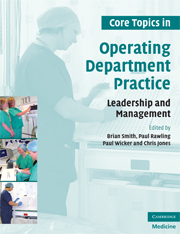Book contents
- Frontmatter
- Contents
- List of contributors
- Foreword
- Preface
- 1 Managing change in perioperative education
- 2 The role of the operating department manager within the context of the organization
- 3 Action learning: a new way of problem solving in perioperative settings
- 4 Agenda for change: what do theatre staff need to know?
- 5 The SWOT analysis: its place in strategic planning in a modern operating department
- 6 Corporate governance: setting the scene for perioperative practice
- 7 Managing different cultures: adversity and diversity in the perioperative environment
- 8 Leadership in perioperative settings: a practical guide
- 9 Management and leadership of advanced practice
- 10 Managing conflict in perioperative settings
- 11 The management and organization of emergency operating lists
- 12 Organizational culture
- 13 Development matters in the NHS; including a perioperative approach to the KSF
- 14 Equipment procurement: a purchaser's guide for theatre managers
- 15 The reflective practitioner in perioperative settings
- 16 New ways of working in perioperative practice
- 17 Damned if you do and damned if you don't: whistle blowing in perioperative practice
- 18 A manager's experience of recruitment and retention
- 19 The management of change
- Index
- References
8 - Leadership in perioperative settings: a practical guide
- Frontmatter
- Contents
- List of contributors
- Foreword
- Preface
- 1 Managing change in perioperative education
- 2 The role of the operating department manager within the context of the organization
- 3 Action learning: a new way of problem solving in perioperative settings
- 4 Agenda for change: what do theatre staff need to know?
- 5 The SWOT analysis: its place in strategic planning in a modern operating department
- 6 Corporate governance: setting the scene for perioperative practice
- 7 Managing different cultures: adversity and diversity in the perioperative environment
- 8 Leadership in perioperative settings: a practical guide
- 9 Management and leadership of advanced practice
- 10 Managing conflict in perioperative settings
- 11 The management and organization of emergency operating lists
- 12 Organizational culture
- 13 Development matters in the NHS; including a perioperative approach to the KSF
- 14 Equipment procurement: a purchaser's guide for theatre managers
- 15 The reflective practitioner in perioperative settings
- 16 New ways of working in perioperative practice
- 17 Damned if you do and damned if you don't: whistle blowing in perioperative practice
- 18 A manager's experience of recruitment and retention
- 19 The management of change
- Index
- References
Summary
Key Learning Points
Appreciate what good leadership is, and what it is not
Understand the nature of leadership and whether it is a quality that can be taught or learned
Appreciate the qualities of established leaders
Identify ways of improving leadership in perioperative settings
People often misunderstand and misuse the terms leadership and management. It is possible to be a good leader without being a manager, or even without having the word management in a job description. Equally, it is possible for a person to be a successful manager without the team perceiving that person to be a leader. The question is what exactly is the difference between leadership and management. There are many ways to distinguish between management and leadership and the following is my preferred definition.
Management is about tasks, systems and processes; leadership is about people. You lead a team and manage a bank account. Leadership is about identifying and delivering a vision.
Leadership is, therefore, about people and about developing and communicating a vision; it is also about creating an environment in which everyone works towards a common goal or objective. To be successful, a leader does not require formal academic learning or training in management techniques (although many may choose to aim for these). The most important point to remember is that a leader cannot be a leader without followers.
Whether good leaders are born or created is a debate that runs and runs. My view is that it is both.
- Type
- Chapter
- Information
- Core Topics in Operating Department PracticeLeadership and Management, pp. 57 - 64Publisher: Cambridge University PressPrint publication year: 2009

